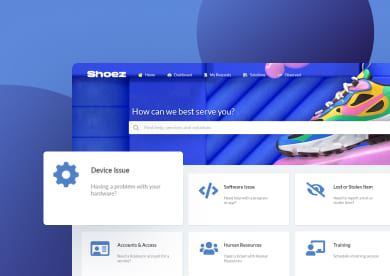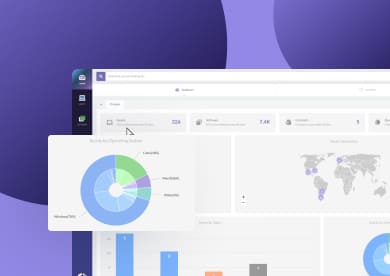A digital transformation roadmap is a structured, goal-oriented plan that reflects how your organization actually operates — and where it’s trying to go.
Some companies start with customer experience. Others prioritize data governance, internal automation, or compliance. No matter the entry point, the roadmap needs to connect those efforts to technology, workflows, and long-term business value.
Many plans fail here. They define high-level goals but skip the operational groundwork needed to support them. That’s especially important for organizations that want to move beyond fragmented tools or short-term fixes. A well-designed plan, on the other hand, can guide transformation across different departments, helping align efforts and identify the enablers each area needs.
Let's review how to plan for digital transformation, step by step.
Digital transformation roadmap main components
A digital transformation roadmap is a strategic document that lays out how an organization will shift from its current operational model to a more digital, data-driven, and scalable one. It covers more than just IT projects or product rollouts. It creates alignment across the business by breaking down the transformation into defined phases, with clear objectives, responsible teams, and measurable outcomes.
Without a roadmap, digital initiatives risk failing, stalling, or creating more complexity than they solve. A well-designed plan, on the other hand, can guide transformation across different departments, helping align efforts and identify the enablers each area needs.
Key elements of a digital transformation roadmap often include:
- A clear vision or strategic objective.
- A current-state assessment (processes, systems, culture).
- Future-state goals.
- Initiatives mapped by quarter or phase.
- Supporting capabilities or tools.
- Metrics to track progress.
The format and structure of a roadmap can vary depending on the size and needs of the organization. Some companies build separate roadmaps for different business areas — like IT, HR, or operations — while others maintain a single, unified plan with cross-functional ownership.
Either way, the roadmap should create focus. It should help decision-makers prioritize, communicate progress, and make adjustments based on what’s working (or not).

How to define a digital transformation roadmap in 5 steps
A digital transformation roadmap outlines how your organization will evolve to meet modern demands. That could mean better tools, more responsive processes, or stronger alignment across teams. But a good roadmap does more than list projects. It connects strategy with execution. It identifies what needs to change, who it affects, and how progress will be measured.
The key is not to start from your org chart or tech stack, but from how your organization delivers value, internally and externally.
Here’s a way to structure that process:
1. Define key focus areas
Start by deciding which parts of the organization the roadmap will address. Some companies focus first on customer experience. Others begin with internal operations or decision-making processes. What matters is clarity—trying to change everything at once often leads to vague, unfocused initiatives.
You might organize your roadmap around:
- Internal processes (e.g., approvals, documentation, employee support).
- Customer interactions (e.g., digital services, feedback loops, onboarding).
- Decision intelligence (e.g., analytics, forecasting, cross-departmental insights).
The focus areas you choose will shape the structure of the roadmap and the types of changes it prioritizes.
2. Analyze how work gets done today
Transformation isn’t about replacing every tool or system—it’s about understanding how work currently flows across people, platforms, and channels, and identifying what’s slowing it down.
Questions to explore:
- Where are the delays or handoff issues?
- Are people jumping between too many systems?
- Do teams have the information they need when they need it?
- Are manual tasks eating up time that could be automated?
This analysis helps ground your roadmap in current-state reality instead of jumping straight to ideal solutions.
3. Set specific, experience-driven goals
Once you understand how things currently work, define where you want to go, and what “better” looks like. Keep goals practical, measurable, and tied to actual experiences.
For example:
- Reduce time to complete internal requests (e.g., purchases, access, support).
- Give managers real-time visibility into project or resource status.
- Make it easier for customers to resolve issues without escalation.
- Shorten the onboarding time for new employees or vendors.
Each goal should reflect a pain point and a desired outcome — not just implement technology for its own sake.
4. Identify enablers — not just tools
Technology plays a role, but it’s only one part of the picture. A real enabler might be a new platform, a redesigned workflow, clearer accountability, or a shared dataset across teams.
Ask:
- What needs to exist for the goal to succeed?
- What needs to stop happening?
- What behaviors or structures will need to shift?
5. Structure initiatives in phases
Instead of a monolithic “transformation,” break your roadmap into phases or waves, each tied to a focus area and a clear set of deliverables.
Each phase should:
- Solve a specific problem or improve a key experience.
- Be feasible based on current maturity and capacity.
- Include a way to measure progress and adjust.
You can prioritize phases based on impact, urgency, or how foundational they are to later improvements.
Digital transformation roadmap template
To help structure your efforts, we’ve created a digital transformation roadmap template you can customize. It includes fields for:
- Business objectives
- Current state assessment
- Key initiatives
- Phases and timelines
- Roles and responsibilities
- KPIs and progress indicators

Use this as a starting point. Adjust based on your organization's context and complexity.
Roadmap for digital transformation strategy examples
Below are three example roadmaps based on common focus areas: internal operations, customer experience, and service management as a foundation for enterprise-wide change.
1. Internal operations: building clarity and automation into daily work
Focus: Improve internal processes across departments to reduce friction and make work more predictable.
Roadmap outline:
- Phase 1: Map core processes (approvals, onboarding, requests) across HR, Finance, and Admin. Identify delays and duplicated work.
- Phase 2: Introduce shared workflows and standardized request portals to reduce informal back-and-forth.
- Phase 3: Automate repetitive tasks (e.g., status updates, notifications, routine approvals).
- Phase 4: Use dashboards to surface blockers and show trends in service delivery across teams.
Enablers: workflow automation platform, process documentation, shared request catalog, training on new systems.
2. Enterprise Service Management: Creating a foundation for cross-team coordination
Focus: A digital transformation initiative based on ITSM principles. Establish a shared way to manage requests, assets, and service delivery across business units — starting with IT, but not ending there.
Roadmap outline:
- Phase 1: Standardize IT processes (incident, request, change) and consolidate toolsets to reduce noise.
- Phase 2: Extend Service Management principles to HR, Facilities, and Procurement — using the same platform and service catalog.
- Phase 3: Integrate IT Asset Management into service processes, so teams can track the full lifecycle of resources.
- Phase 4: Use shared reporting and dashboards to connect service performance with business outcomes.
Enablers: IT Service Management platform (ITSM/ESM), asset database (CMDB or equivalent), catalog-driven workflows, unified support model.
3. Customer experience: improving digital touchpoints and support
Focus: Enhance the way customers interact with your services — from first contact to resolution.
Roadmap outline:
- Phase 1: Audit customer-facing channels (web, app, support) for fragmentation or inconsistency.
- Phase 2: Unify key interactions — like submitting requests, getting status updates, or finding help — in a single interface.
- Phase 3: Add self-service tools, knowledge bases, and feedback loops to reduce dependency on live support.
- Phase 4: Connect customer data across departments to enable personalized support and better handoffs.
Enablers: omnichannel support platform, knowledge base, customer journey mapping, analytics for service quality.

Conclusion
Building a digital transformation roadmap is how organizations turn ambition into tangible change. When your roadmap is tied to real outcomes, supported by the right tools, and grounded in how your business actually works, it becomes a blueprint you can act on, not just a list of aspirations.
Whether you're focusing on one department or orchestrating change across multiple functions, defining your phases, enablers, and dependencies helps you move with purpose.
At InvGate, we’ve worked with organizations across industries that all reached the same conclusion: without a strong foundation, digital transformation gets stuck. Tools don’t integrate, data remains siloed, and processes can’t scale. That’s where service-oriented thinking becomes valuable. Structuring efforts around services — like internal support, data flows, and employee experience — brings business and IT closer together.
With a solid Service Management core, digital initiatives are more likely to stick because they’re being built on systems that already track ownership, dependencies, and usage.















